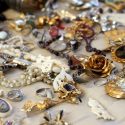Every time period has its own unique styles and trends. However, for vintage jewelry, it can be hard for the average person to determine when a particular piece of jewelry was made, especially when many styles coexisted alongside one another. Edwardian, Victorian, Art Deco, Georgian…there are several design eras that your vintage jewelry could be from:
Georgian: 1714-1837
From the 1710s to the 1830s, there were four King Georges that ruled England (George I – George IV). As such, the jewelry that was worn during that time period was named after them. Opulent and regal, with stones of varying shapes and sizes, Georgian jewelry is extremely rare today.
Victorian: 1837-1901
In 1837, the reign of the Georges ended when Queen Victoria came to the throne. Whatever Victoria wore, the people followed in suit; it’s why when her husband Prince Albert passed away, mourning jewelry became increasingly popular, featuring dark stones and motifs such as skulls and skeletons. However, when Victoria’s mourning period ended, jewelry became more care-free, featuring floral and nature motifs.
Art Nouveau: 1890-1910
Art Nouveau jewelry coincided with the end of the Victorian and the beginning of the Edwardian (see below). Unlike previous design eras, it’s associated with the art movement Art Nouveau (“new art”). It was decidedly woman-centric by emphasizing nature motifs and mythical women such as Medusa.
Edwardian: 1901-1920
When Queen Victoria died in 1901, her son Edward became king, ushering in the Edwardian Era and Edwardian jewelry. This type of jewelry was created to go with the elaborate dresses of the time period, and they typically highlight a key element, such as a gemstone or pearl.
Art Deco: 1920-1930
After the end of World War I and the end of King Edward’s reign, jewelry reflected the roaring 20s. Stylish and fun, art deco jewelry used bold accent gems, geometric patterns, and bright colors to let people express their individuality.
Retro: 1930-1950
Despite coinciding with the Great Depression and World War II, retro jewelry is big, bold, and glamorous. It expressed the glamor of Hollywood’s golden age, using large colored gems set in gold.
Mid-Century: 1940s-1960s
Alongside the retro style was mid-century. Heavily influenced by the Modernist art movement, mid-century jewelry used shapes and science motifs, along with extremely detailed animal designs and colored stones.
Contemporary: 1970s-Present
Contemporary jewelry is everything that was made from the 1970s to the present day. As such, contemporary styles are extremely varied, utilizing all sorts of materials, techniques, and motifs.
Each design era has its own unique touch, making them excellent additions to your wardrobe. So, if you’re looking for a piece of vintage jewelry to add to your collection, or if you’re planning to sell some of your vintage jewelry, be sure to contact Frank Pollak & Sons to see how we can help.

